Sex, Crime and Justice: Identity Crimes, CCTV, and Justice System
VerifiedAdded on 2020/05/28
|6
|1404
|101
Essay
AI Summary
This essay, titled "Sex, Crime and Justice," explores the multifaceted issues of identity crimes and the use of Closed Circuit Television (CCTV) surveillance in the context of the justice system. The first section defines identity crimes, including identity theft, deception, and fraud, detailing their impact on individuals and society, with statistical data on their prevalence and financial implications, particularly in Australia. It emphasizes the role of identity crimes as facilitators of other criminal activities, including organized crime. The second section discusses the concept of the "myopic panopticon," drawing on Jeremy Bentham's design and its modern application through CCTV. It analyzes the effectiveness of CCTV in crime reduction, citing research findings on its impact on different types of crimes and locations. The essay also touches upon the role of CCTV in counter-terrorism efforts. The essay concludes by highlighting the benefits of CCTV in maintaining public order for specific sets of crimes. The references section includes a comprehensive list of sources.
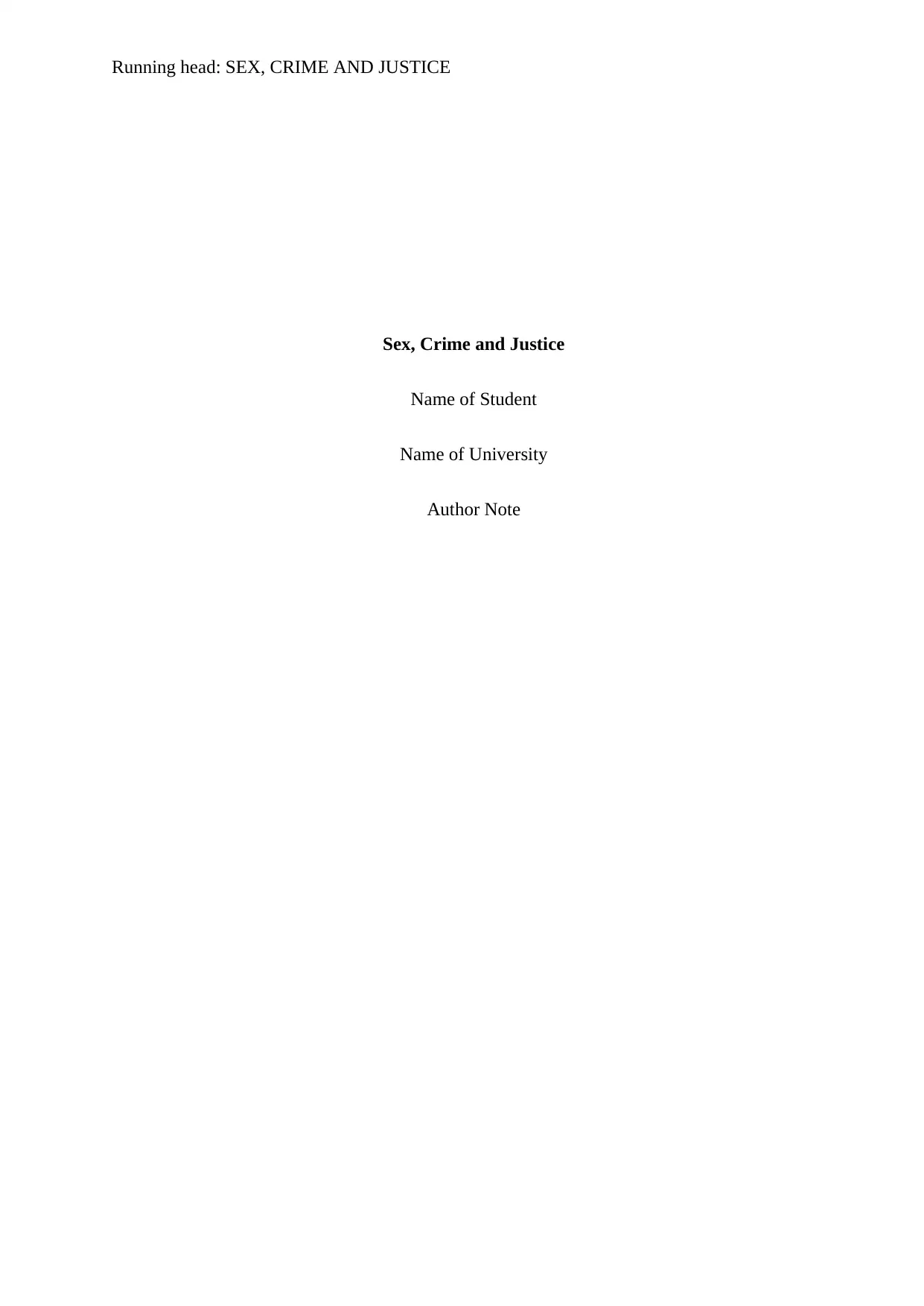
Running head: SEX, CRIME AND JUSTICE
Sex, Crime and Justice
Name of Student
Name of University
Author Note
Sex, Crime and Justice
Name of Student
Name of University
Author Note
Paraphrase This Document
Need a fresh take? Get an instant paraphrase of this document with our AI Paraphraser

1
SEX, CRIME AND JUSTICE
Table of Contents
1. Identity crimes and their impact on individuals and society.......................................................2
2. Myopic panopticon and effect of use of CCTV on commission of crimes.................................3
References........................................................................................................................................6
SEX, CRIME AND JUSTICE
Table of Contents
1. Identity crimes and their impact on individuals and society.......................................................2
2. Myopic panopticon and effect of use of CCTV on commission of crimes.................................3
References........................................................................................................................................6
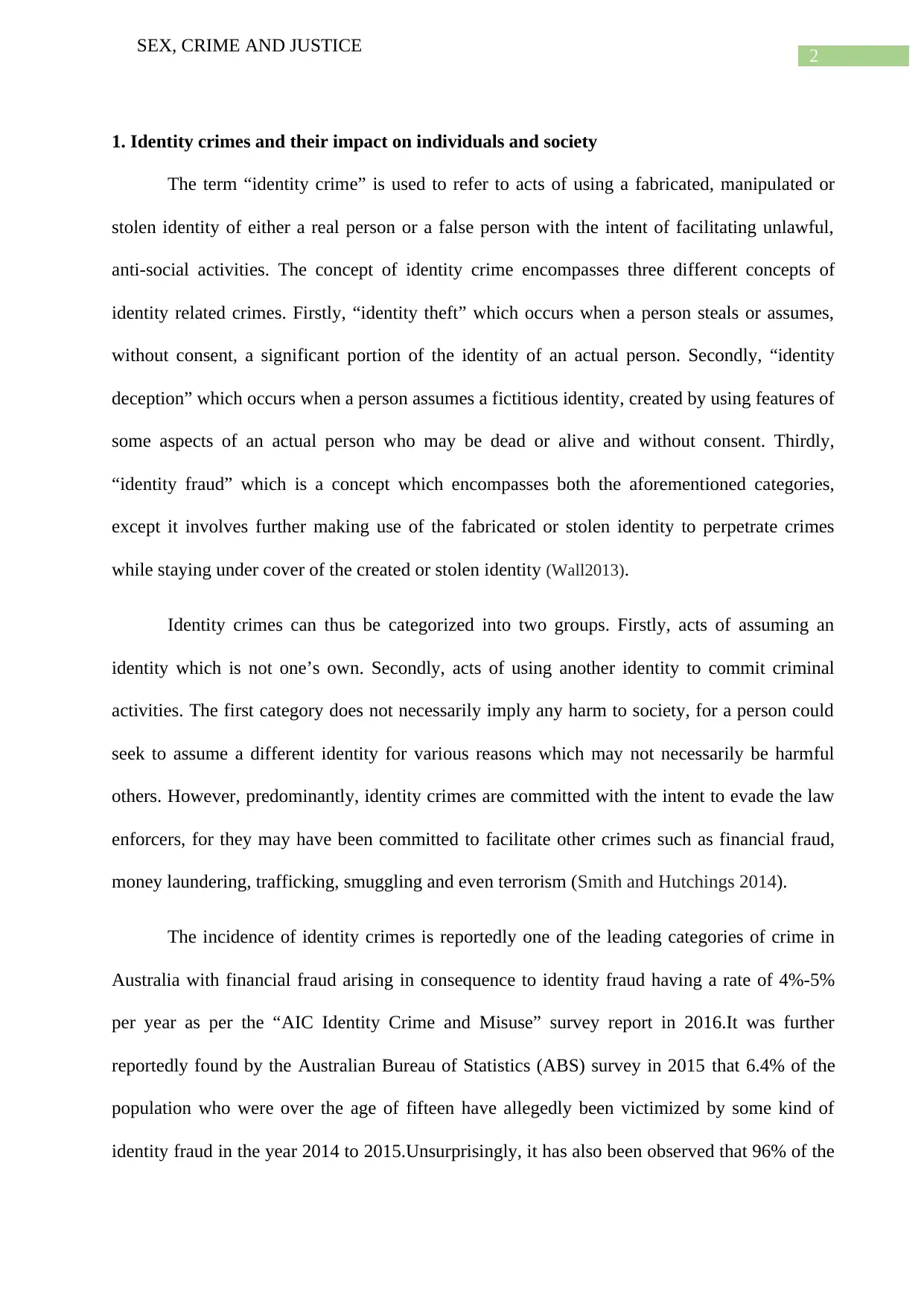
2
SEX, CRIME AND JUSTICE
1. Identity crimes and their impact on individuals and society
The term “identity crime” is used to refer to acts of using a fabricated, manipulated or
stolen identity of either a real person or a false person with the intent of facilitating unlawful,
anti-social activities. The concept of identity crime encompasses three different concepts of
identity related crimes. Firstly, “identity theft” which occurs when a person steals or assumes,
without consent, a significant portion of the identity of an actual person. Secondly, “identity
deception” which occurs when a person assumes a fictitious identity, created by using features of
some aspects of an actual person who may be dead or alive and without consent. Thirdly,
“identity fraud” which is a concept which encompasses both the aforementioned categories,
except it involves further making use of the fabricated or stolen identity to perpetrate crimes
while staying under cover of the created or stolen identity (Wall2013).
Identity crimes can thus be categorized into two groups. Firstly, acts of assuming an
identity which is not one’s own. Secondly, acts of using another identity to commit criminal
activities. The first category does not necessarily imply any harm to society, for a person could
seek to assume a different identity for various reasons which may not necessarily be harmful
others. However, predominantly, identity crimes are committed with the intent to evade the law
enforcers, for they may have been committed to facilitate other crimes such as financial fraud,
money laundering, trafficking, smuggling and even terrorism (Smith and Hutchings 2014).
The incidence of identity crimes is reportedly one of the leading categories of crime in
Australia with financial fraud arising in consequence to identity fraud having a rate of 4%-5%
per year as per the “AIC Identity Crime and Misuse” survey report in 2016.It was further
reportedly found by the Australian Bureau of Statistics (ABS) survey in 2015 that 6.4% of the
population who were over the age of fifteen have allegedly been victimized by some kind of
identity fraud in the year 2014 to 2015.Unsurprisingly, it has also been observed that 96% of the
SEX, CRIME AND JUSTICE
1. Identity crimes and their impact on individuals and society
The term “identity crime” is used to refer to acts of using a fabricated, manipulated or
stolen identity of either a real person or a false person with the intent of facilitating unlawful,
anti-social activities. The concept of identity crime encompasses three different concepts of
identity related crimes. Firstly, “identity theft” which occurs when a person steals or assumes,
without consent, a significant portion of the identity of an actual person. Secondly, “identity
deception” which occurs when a person assumes a fictitious identity, created by using features of
some aspects of an actual person who may be dead or alive and without consent. Thirdly,
“identity fraud” which is a concept which encompasses both the aforementioned categories,
except it involves further making use of the fabricated or stolen identity to perpetrate crimes
while staying under cover of the created or stolen identity (Wall2013).
Identity crimes can thus be categorized into two groups. Firstly, acts of assuming an
identity which is not one’s own. Secondly, acts of using another identity to commit criminal
activities. The first category does not necessarily imply any harm to society, for a person could
seek to assume a different identity for various reasons which may not necessarily be harmful
others. However, predominantly, identity crimes are committed with the intent to evade the law
enforcers, for they may have been committed to facilitate other crimes such as financial fraud,
money laundering, trafficking, smuggling and even terrorism (Smith and Hutchings 2014).
The incidence of identity crimes is reportedly one of the leading categories of crime in
Australia with financial fraud arising in consequence to identity fraud having a rate of 4%-5%
per year as per the “AIC Identity Crime and Misuse” survey report in 2016.It was further
reportedly found by the Australian Bureau of Statistics (ABS) survey in 2015 that 6.4% of the
population who were over the age of fifteen have allegedly been victimized by some kind of
identity fraud in the year 2014 to 2015.Unsurprisingly, it has also been observed that 96% of the
⊘ This is a preview!⊘
Do you want full access?
Subscribe today to unlock all pages.

Trusted by 1+ million students worldwide
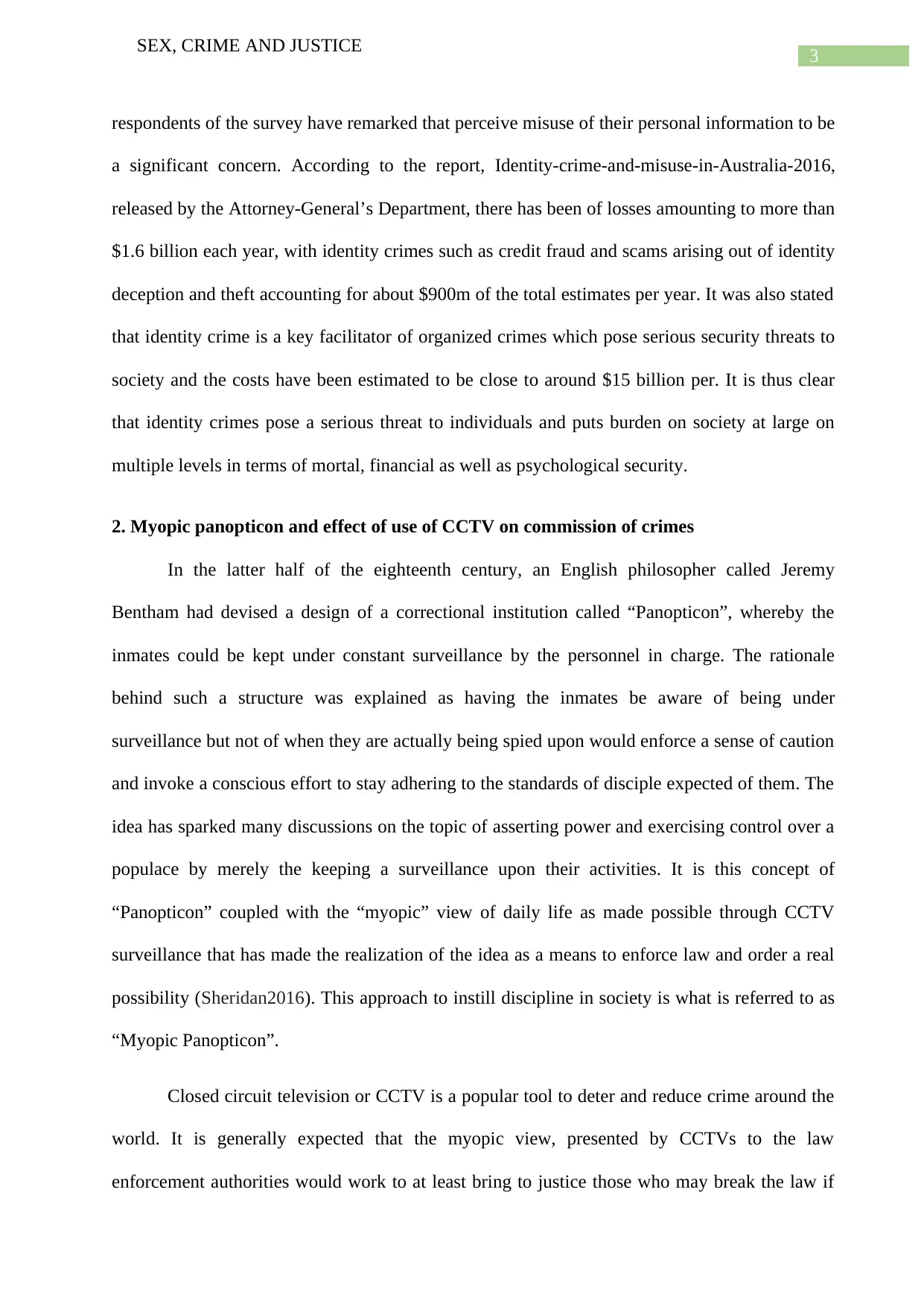
3
SEX, CRIME AND JUSTICE
respondents of the survey have remarked that perceive misuse of their personal information to be
a significant concern. According to the report, Identity-crime-and-misuse-in-Australia-2016,
released by the Attorney-General’s Department, there has been of losses amounting to more than
$1.6 billion each year, with identity crimes such as credit fraud and scams arising out of identity
deception and theft accounting for about $900m of the total estimates per year. It was also stated
that identity crime is a key facilitator of organized crimes which pose serious security threats to
society and the costs have been estimated to be close to around $15 billion per. It is thus clear
that identity crimes pose a serious threat to individuals and puts burden on society at large on
multiple levels in terms of mortal, financial as well as psychological security.
2. Myopic panopticon and effect of use of CCTV on commission of crimes
In the latter half of the eighteenth century, an English philosopher called Jeremy
Bentham had devised a design of a correctional institution called “Panopticon”, whereby the
inmates could be kept under constant surveillance by the personnel in charge. The rationale
behind such a structure was explained as having the inmates be aware of being under
surveillance but not of when they are actually being spied upon would enforce a sense of caution
and invoke a conscious effort to stay adhering to the standards of disciple expected of them. The
idea has sparked many discussions on the topic of asserting power and exercising control over a
populace by merely the keeping a surveillance upon their activities. It is this concept of
“Panopticon” coupled with the “myopic” view of daily life as made possible through CCTV
surveillance that has made the realization of the idea as a means to enforce law and order a real
possibility (Sheridan2016). This approach to instill discipline in society is what is referred to as
“Myopic Panopticon”.
Closed circuit television or CCTV is a popular tool to deter and reduce crime around the
world. It is generally expected that the myopic view, presented by CCTVs to the law
enforcement authorities would work to at least bring to justice those who may break the law if
SEX, CRIME AND JUSTICE
respondents of the survey have remarked that perceive misuse of their personal information to be
a significant concern. According to the report, Identity-crime-and-misuse-in-Australia-2016,
released by the Attorney-General’s Department, there has been of losses amounting to more than
$1.6 billion each year, with identity crimes such as credit fraud and scams arising out of identity
deception and theft accounting for about $900m of the total estimates per year. It was also stated
that identity crime is a key facilitator of organized crimes which pose serious security threats to
society and the costs have been estimated to be close to around $15 billion per. It is thus clear
that identity crimes pose a serious threat to individuals and puts burden on society at large on
multiple levels in terms of mortal, financial as well as psychological security.
2. Myopic panopticon and effect of use of CCTV on commission of crimes
In the latter half of the eighteenth century, an English philosopher called Jeremy
Bentham had devised a design of a correctional institution called “Panopticon”, whereby the
inmates could be kept under constant surveillance by the personnel in charge. The rationale
behind such a structure was explained as having the inmates be aware of being under
surveillance but not of when they are actually being spied upon would enforce a sense of caution
and invoke a conscious effort to stay adhering to the standards of disciple expected of them. The
idea has sparked many discussions on the topic of asserting power and exercising control over a
populace by merely the keeping a surveillance upon their activities. It is this concept of
“Panopticon” coupled with the “myopic” view of daily life as made possible through CCTV
surveillance that has made the realization of the idea as a means to enforce law and order a real
possibility (Sheridan2016). This approach to instill discipline in society is what is referred to as
“Myopic Panopticon”.
Closed circuit television or CCTV is a popular tool to deter and reduce crime around the
world. It is generally expected that the myopic view, presented by CCTVs to the law
enforcement authorities would work to at least bring to justice those who may break the law if
Paraphrase This Document
Need a fresh take? Get an instant paraphrase of this document with our AI Paraphraser
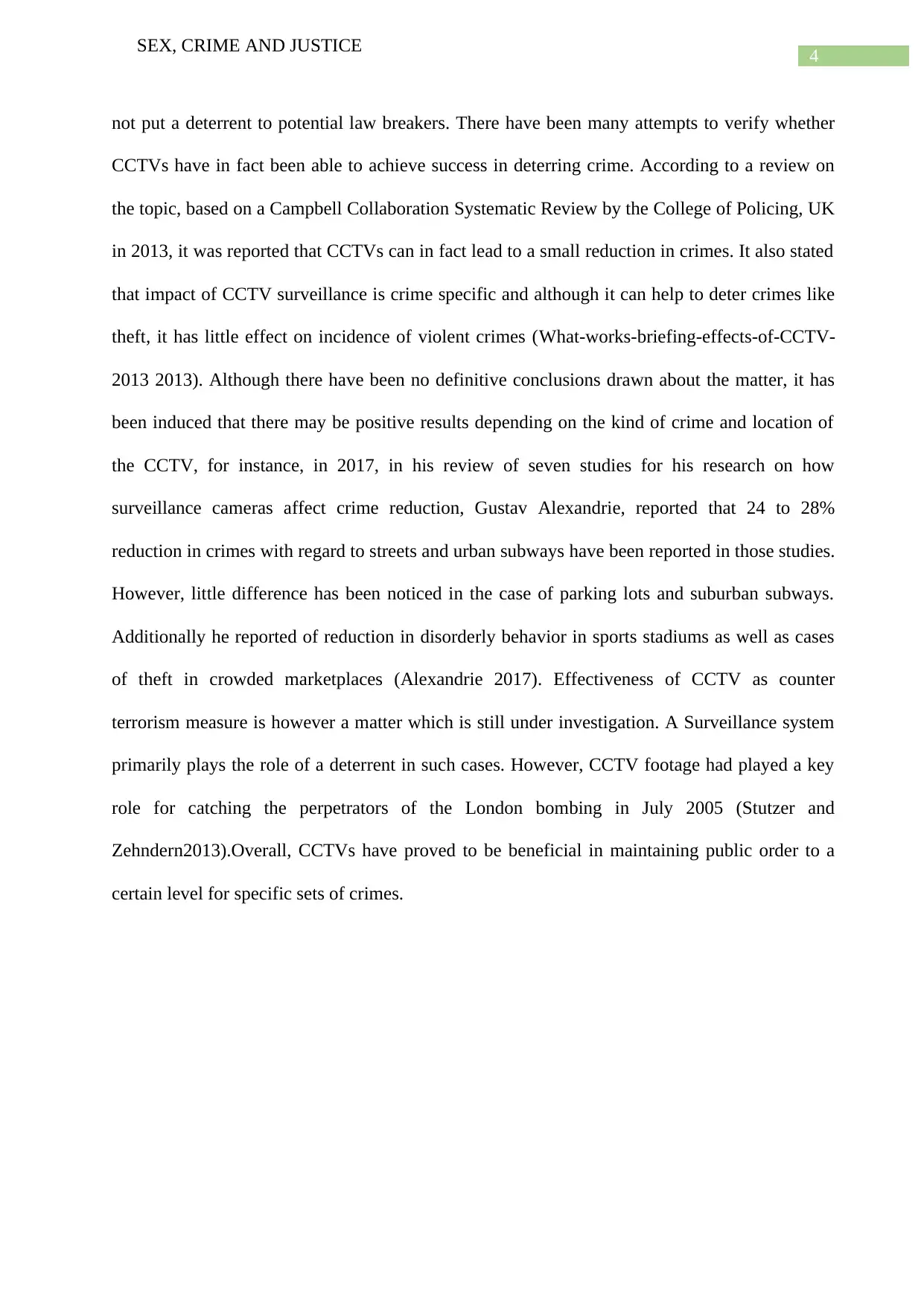
4
SEX, CRIME AND JUSTICE
not put a deterrent to potential law breakers. There have been many attempts to verify whether
CCTVs have in fact been able to achieve success in deterring crime. According to a review on
the topic, based on a Campbell Collaboration Systematic Review by the College of Policing, UK
in 2013, it was reported that CCTVs can in fact lead to a small reduction in crimes. It also stated
that impact of CCTV surveillance is crime specific and although it can help to deter crimes like
theft, it has little effect on incidence of violent crimes (What-works-briefing-effects-of-CCTV-
2013 2013). Although there have been no definitive conclusions drawn about the matter, it has
been induced that there may be positive results depending on the kind of crime and location of
the CCTV, for instance, in 2017, in his review of seven studies for his research on how
surveillance cameras affect crime reduction, Gustav Alexandrie, reported that 24 to 28%
reduction in crimes with regard to streets and urban subways have been reported in those studies.
However, little difference has been noticed in the case of parking lots and suburban subways.
Additionally he reported of reduction in disorderly behavior in sports stadiums as well as cases
of theft in crowded marketplaces (Alexandrie 2017). Effectiveness of CCTV as counter
terrorism measure is however a matter which is still under investigation. A Surveillance system
primarily plays the role of a deterrent in such cases. However, CCTV footage had played a key
role for catching the perpetrators of the London bombing in July 2005 (Stutzer and
Zehndern2013).Overall, CCTVs have proved to be beneficial in maintaining public order to a
certain level for specific sets of crimes.
SEX, CRIME AND JUSTICE
not put a deterrent to potential law breakers. There have been many attempts to verify whether
CCTVs have in fact been able to achieve success in deterring crime. According to a review on
the topic, based on a Campbell Collaboration Systematic Review by the College of Policing, UK
in 2013, it was reported that CCTVs can in fact lead to a small reduction in crimes. It also stated
that impact of CCTV surveillance is crime specific and although it can help to deter crimes like
theft, it has little effect on incidence of violent crimes (What-works-briefing-effects-of-CCTV-
2013 2013). Although there have been no definitive conclusions drawn about the matter, it has
been induced that there may be positive results depending on the kind of crime and location of
the CCTV, for instance, in 2017, in his review of seven studies for his research on how
surveillance cameras affect crime reduction, Gustav Alexandrie, reported that 24 to 28%
reduction in crimes with regard to streets and urban subways have been reported in those studies.
However, little difference has been noticed in the case of parking lots and suburban subways.
Additionally he reported of reduction in disorderly behavior in sports stadiums as well as cases
of theft in crowded marketplaces (Alexandrie 2017). Effectiveness of CCTV as counter
terrorism measure is however a matter which is still under investigation. A Surveillance system
primarily plays the role of a deterrent in such cases. However, CCTV footage had played a key
role for catching the perpetrators of the London bombing in July 2005 (Stutzer and
Zehndern2013).Overall, CCTVs have proved to be beneficial in maintaining public order to a
certain level for specific sets of crimes.
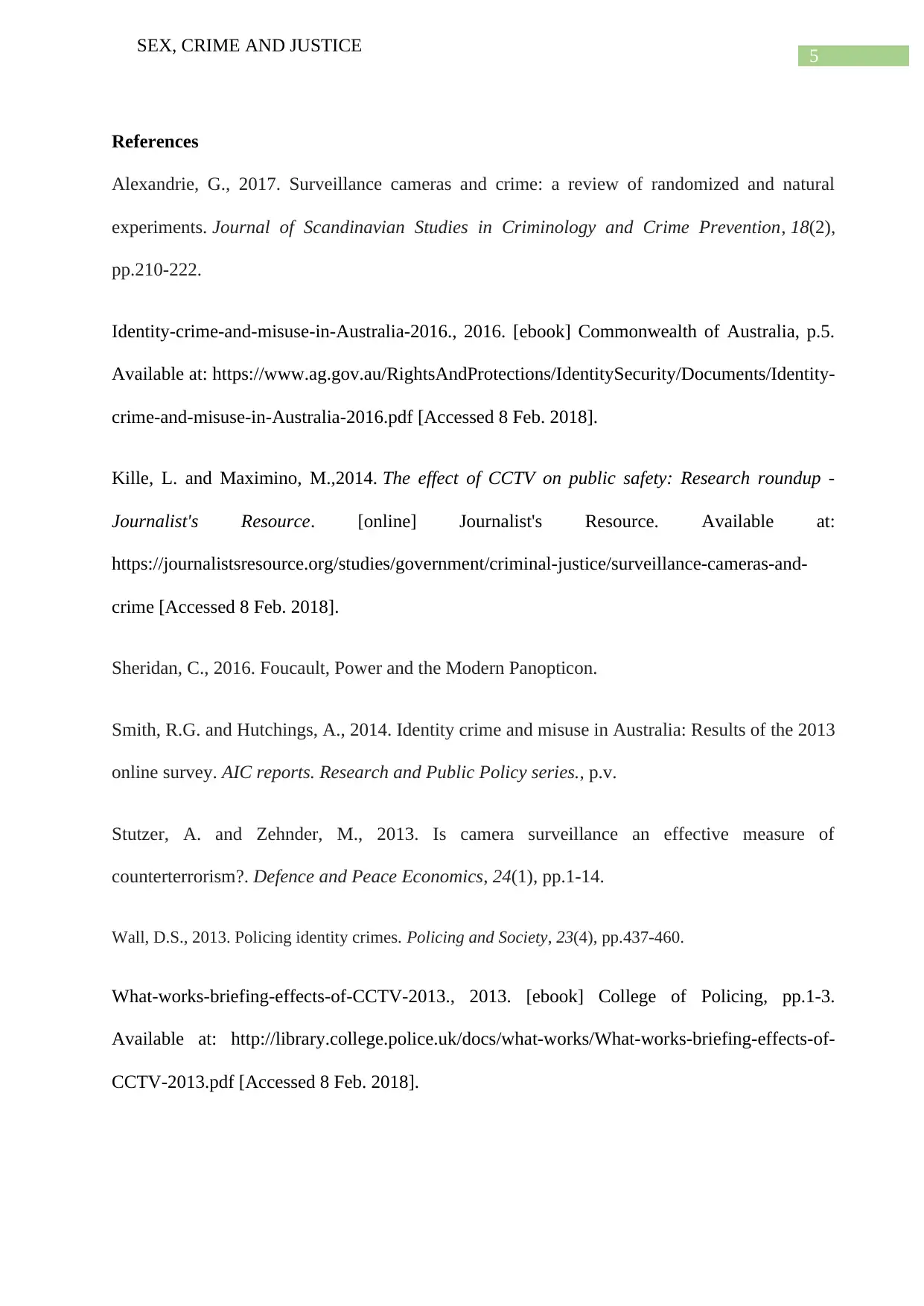
5
SEX, CRIME AND JUSTICE
References
Alexandrie, G., 2017. Surveillance cameras and crime: a review of randomized and natural
experiments. Journal of Scandinavian Studies in Criminology and Crime Prevention, 18(2),
pp.210-222.
Identity-crime-and-misuse-in-Australia-2016., 2016. [ebook] Commonwealth of Australia, p.5.
Available at: https://www.ag.gov.au/RightsAndProtections/IdentitySecurity/Documents/Identity-
crime-and-misuse-in-Australia-2016.pdf [Accessed 8 Feb. 2018].
Kille, L. and Maximino, M.,2014. The effect of CCTV on public safety: Research roundup -
Journalist's Resource. [online] Journalist's Resource. Available at:
https://journalistsresource.org/studies/government/criminal-justice/surveillance-cameras-and-
crime [Accessed 8 Feb. 2018].
Sheridan, C., 2016. Foucault, Power and the Modern Panopticon.
Smith, R.G. and Hutchings, A., 2014. Identity crime and misuse in Australia: Results of the 2013
online survey. AIC reports. Research and Public Policy series., p.v.
Stutzer, A. and Zehnder, M., 2013. Is camera surveillance an effective measure of
counterterrorism?. Defence and Peace Economics, 24(1), pp.1-14.
Wall, D.S., 2013. Policing identity crimes. Policing and Society, 23(4), pp.437-460.
What-works-briefing-effects-of-CCTV-2013., 2013. [ebook] College of Policing, pp.1-3.
Available at: http://library.college.police.uk/docs/what-works/What-works-briefing-effects-of-
CCTV-2013.pdf [Accessed 8 Feb. 2018].
SEX, CRIME AND JUSTICE
References
Alexandrie, G., 2017. Surveillance cameras and crime: a review of randomized and natural
experiments. Journal of Scandinavian Studies in Criminology and Crime Prevention, 18(2),
pp.210-222.
Identity-crime-and-misuse-in-Australia-2016., 2016. [ebook] Commonwealth of Australia, p.5.
Available at: https://www.ag.gov.au/RightsAndProtections/IdentitySecurity/Documents/Identity-
crime-and-misuse-in-Australia-2016.pdf [Accessed 8 Feb. 2018].
Kille, L. and Maximino, M.,2014. The effect of CCTV on public safety: Research roundup -
Journalist's Resource. [online] Journalist's Resource. Available at:
https://journalistsresource.org/studies/government/criminal-justice/surveillance-cameras-and-
crime [Accessed 8 Feb. 2018].
Sheridan, C., 2016. Foucault, Power and the Modern Panopticon.
Smith, R.G. and Hutchings, A., 2014. Identity crime and misuse in Australia: Results of the 2013
online survey. AIC reports. Research and Public Policy series., p.v.
Stutzer, A. and Zehnder, M., 2013. Is camera surveillance an effective measure of
counterterrorism?. Defence and Peace Economics, 24(1), pp.1-14.
Wall, D.S., 2013. Policing identity crimes. Policing and Society, 23(4), pp.437-460.
What-works-briefing-effects-of-CCTV-2013., 2013. [ebook] College of Policing, pp.1-3.
Available at: http://library.college.police.uk/docs/what-works/What-works-briefing-effects-of-
CCTV-2013.pdf [Accessed 8 Feb. 2018].
⊘ This is a preview!⊘
Do you want full access?
Subscribe today to unlock all pages.

Trusted by 1+ million students worldwide
1 out of 6
Your All-in-One AI-Powered Toolkit for Academic Success.
+13062052269
info@desklib.com
Available 24*7 on WhatsApp / Email
![[object Object]](/_next/static/media/star-bottom.7253800d.svg)
Unlock your academic potential
Copyright © 2020–2025 A2Z Services. All Rights Reserved. Developed and managed by ZUCOL.